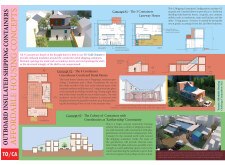5 key facts about this project
The design integrates multiple shipping containers in innovative configurations to create livable spaces. Each concept utilizes strategies aimed at maximizing thermal performance, energy efficiency, and community interaction. The architectural approach considers the existing climatic challenges of Toronto, including cold winters and variable seasonal changes. By incorporating elements such as insulation and thermal mass, these designs focus on creating comfortable living environments year-round.
Unique Community-Centric Design Approaches
A notable aspect of this project is its emphasis on community-oriented designs. Each concept varies in its organization and function, yet they all promote interactions among residents. For instance, one configuration features a cluster of containers arranged in a U-shape, which forms a central courtyard. This design not only provides shared outdoor space for residents but also encourages social activities and gardening, thereby fostering community cohesion.
The integration of a greenhouse within the designs is another distinct feature. The greenhouse serves as a multifunctional space that allows for indoor gardening, while also capturing and utilizing solar energy for heating. This innovative incorporation makes it possible to grow food year-round, contributing to food security and sustainability. Additionally, the use of rammed earth walls in some designs further enhances thermal regulation, working in tandem with the container structure.
Sustainable Material and Design Considerations
Material selection plays a crucial role in the overall sustainability of the project. Shipping containers are repurposed as structural elements, significantly reducing waste and utilizing existing resources. Various insulative materials, though unspecified in detail, are vital for maintaining energy efficiency, especially during winter months. The natural materials such as rammed earth not only function structurally but also provide a low-carbon alternative to conventional building materials.
In conclusion, this project showcases a pragmatic approach to addressing urban housing challenges through the innovative use of shipping containers. It promotes sustainable living and community interaction while offering adaptable housing solutions. For a more in-depth understanding of the architectural plans, sections, and designs, readers are encouraged to explore the project presentation further.























